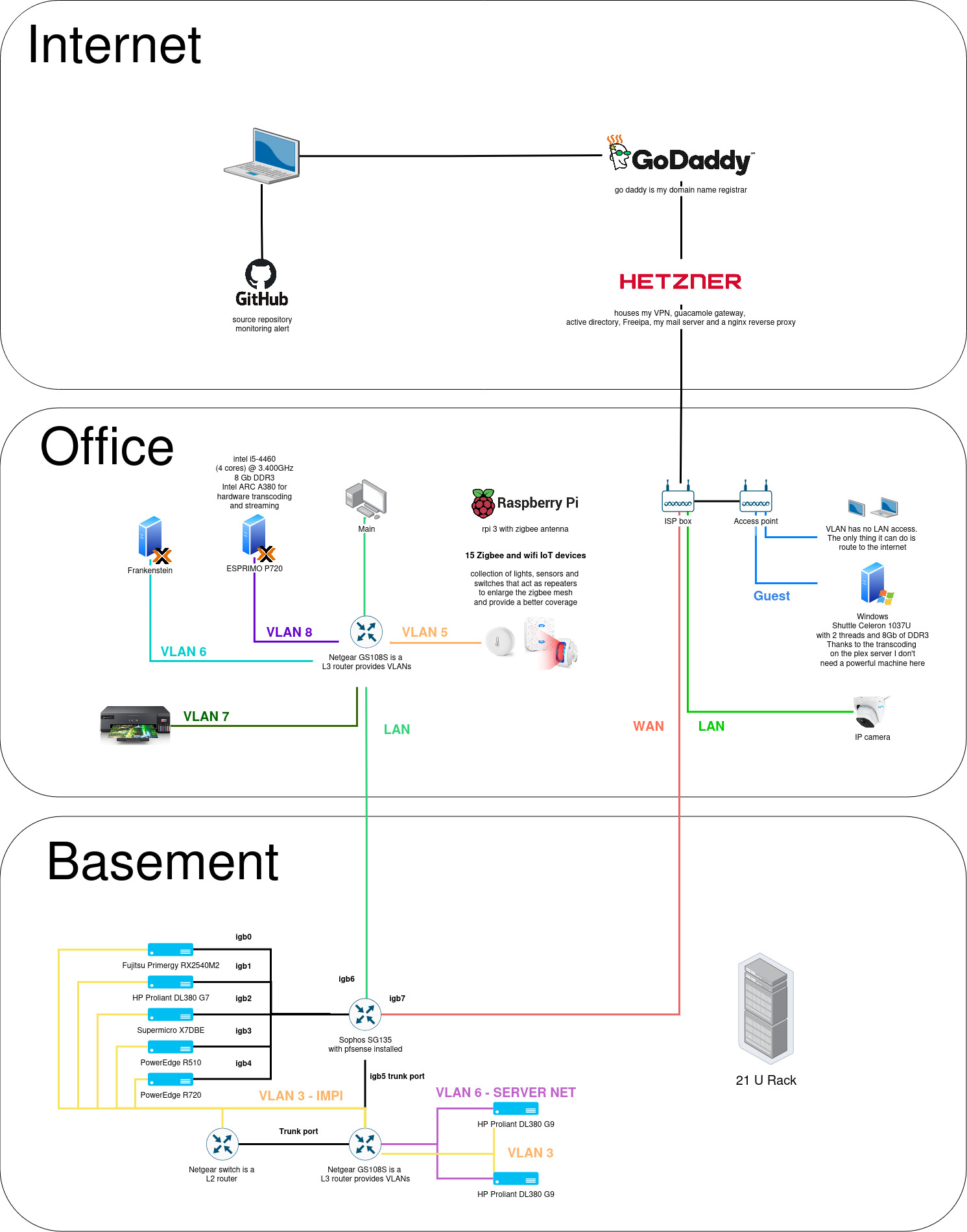Hi, welcome to chirpy thanks for stopping by. I’m a software enthusiast that tinkers with malware, content management systems, devops tools and anything I find useful to my day to day life. I run and host roughly ~ 20 web apps on my own infrastructure. Infrastucture here is a just a fancy word for a small 65 W micro computer with two Intel Celeron CPUs running @ 1.800GHz. I needed something that is as power efficient as possible while also being able to handle the workloads I intend to run in the future. 65 Watts is 0.065 kW which if you multiply by your electricity provider’s cost gets you a good approximation for your bill. Mine is 0.28 euros/kWh = 1,8 cents per hour, 43 cents per day and 159 euros per year. The power consumption largely depends on the usage so if my system is running at 50% on average I can expect that bill to be cut in half. In the next two sections I’ll go over the home lab I built up over the years and the projects I forked or bootstraped myself.
The home lab
Let’s start with an overview of my lab.
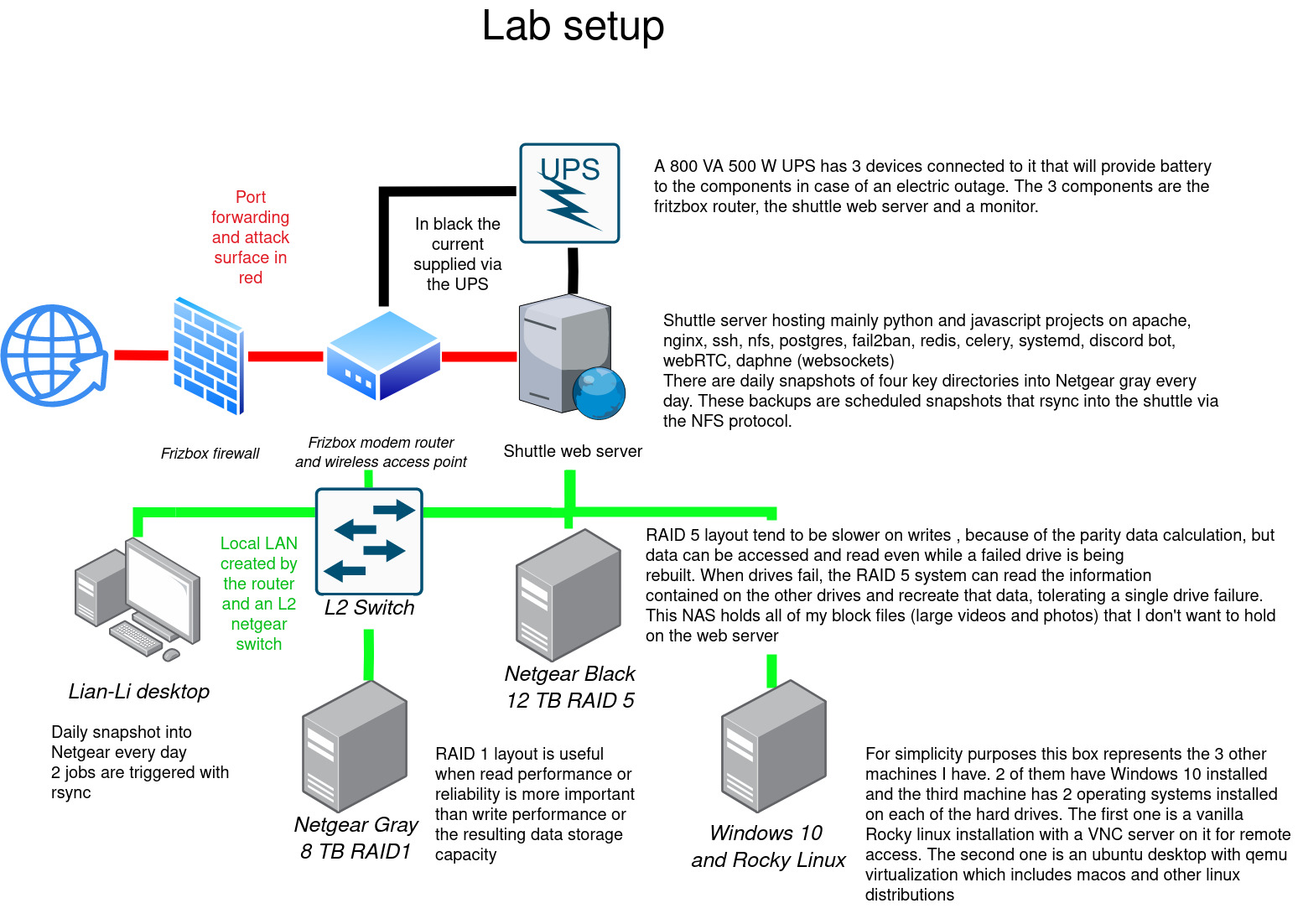
-
2 network attached storage devices (NAS): Referred to above as
Netgear BlackandNetgear Gray.Netgear Gray’s purpose is solely dedictated to doing snapshots once a day with rsync. The device is mounted as a NFS share on all my devices so that they can write to it. I considered using block storage initially but I want to be able to quickly locate and recover a file or folder on it so I kept the classic file storage system. The advantage of using rsync over other solutions was the ability to do incremental snapshotting as opposed to a complete snapshot from scratch every day. My networking cables can only handle around 80-100 MB per second and I don’t want to sleep with a persistent wind turbine noise in the background so I quickly opted for a tool that allowed me to do incremental backups. My second NAS is used to store anything that I don’t access every single day. You could call it my artic vault. -
My lian-li desktop: This PC is used as my main workstation as well as my development/acceptance testing environment. I’m running the latest version of ubuntu desktop on it because I value my time and having updated consistent packages that ‘just work’ is invaluable for me. As for the specs they aren’t anything special and don’t allow me to do any GPU powered brute forcing, video editing or streaming on it. I’m also running an archaic 3rd generation Intel CPU on it and it suits all of my needs perfectly. Here is his technical name: Intel i7-3820 @ 3.800GHz. I do not do any CPU intensive tasks and value memory much more to be able to run all of these memory hungry apps like Electron based ones like Vscode, Spotify and Chrome. I’ll probably ramp up on the memory soon because I do run into some bottlenecks sometimes with my 16 Gb of DDR3 RAM
-
The shuttle web server: This bad boy hosts a variety of programs written in python, javascript and ruby. I’ll go in depth into each of them on the next section. As a spoiler I do run docker on two projects but I do not intend on converting all of my projects into containers. Don’t get me wrong, I think docker is a game changing technology for large corporations and dev teams in general. Docker gives you a way to attain 100% availablity and scalable services. Its also useful to manage the complexity of service oriented architecture. Another great plus of using docker is the fact you can deploy your app with it on Windows, Linux or Mac infrastructure and it will just work. As a software development tool it allows you to quickly set up all required components of your app as well. I have however 5 reasons for not using it for every single project I host.
- I dont have independent lifecycle needs between my apps. If I decide to update postgres I’ll do it for all my apps at the same time
- I can manage all my workers to scale with apache. Systemd allows me to add workers easily.
- If my app bottlenecks on RAM or CPU, installing another 1 Gb service on RAM won’t solve anything. Adding docker in this case would be like spraying gasoline on a fire.
- I don’t do service oriented architecture (SOA) or micro services because i lose the benefit of version control and being able to rollback on my mistakes
- I use a similar environment to the target production so i dont need any fancy packaging system. I can see how they are useful in a team of devs and how easy they make lifecycle management in complex organizations but its hard to set up and tricky to debug with all that extra networking layer and configuration involved
The self hosted programs I run
A picture is worth a thousand words so here is a link to an overview of some of my projects.
I use Upptime’s serverless app to monitor my web apps. It’s currently hosted on Github pages so that I can avoid the cost of spinning up a new virtual machine or virtual private service (VPS) exclusively for it. How it works is pretty simple. The app pings my different endopints every 5 minutes and updates this page accordingly. The svelte app re-builds itself on github servers thanks to the Github actions feature which allows you to run code for free. Thank you microsoft for this awesome feature !
28th of March 2023
7th of February 2024 update: The home lab has grown and evolved since 2023 so I thought I would map out what’s new. The network significanlty improved compared to last year since now I have a separated virtual network for all my front facing applications.
Another significant change is my new love for iot devices which I have sprinkled around the house to light up doorway lights once movement is detected or temperature and humidity sensors that allow me to contemplate my errors once i realize for example that I went on vacation and forgot to turn off the heater.
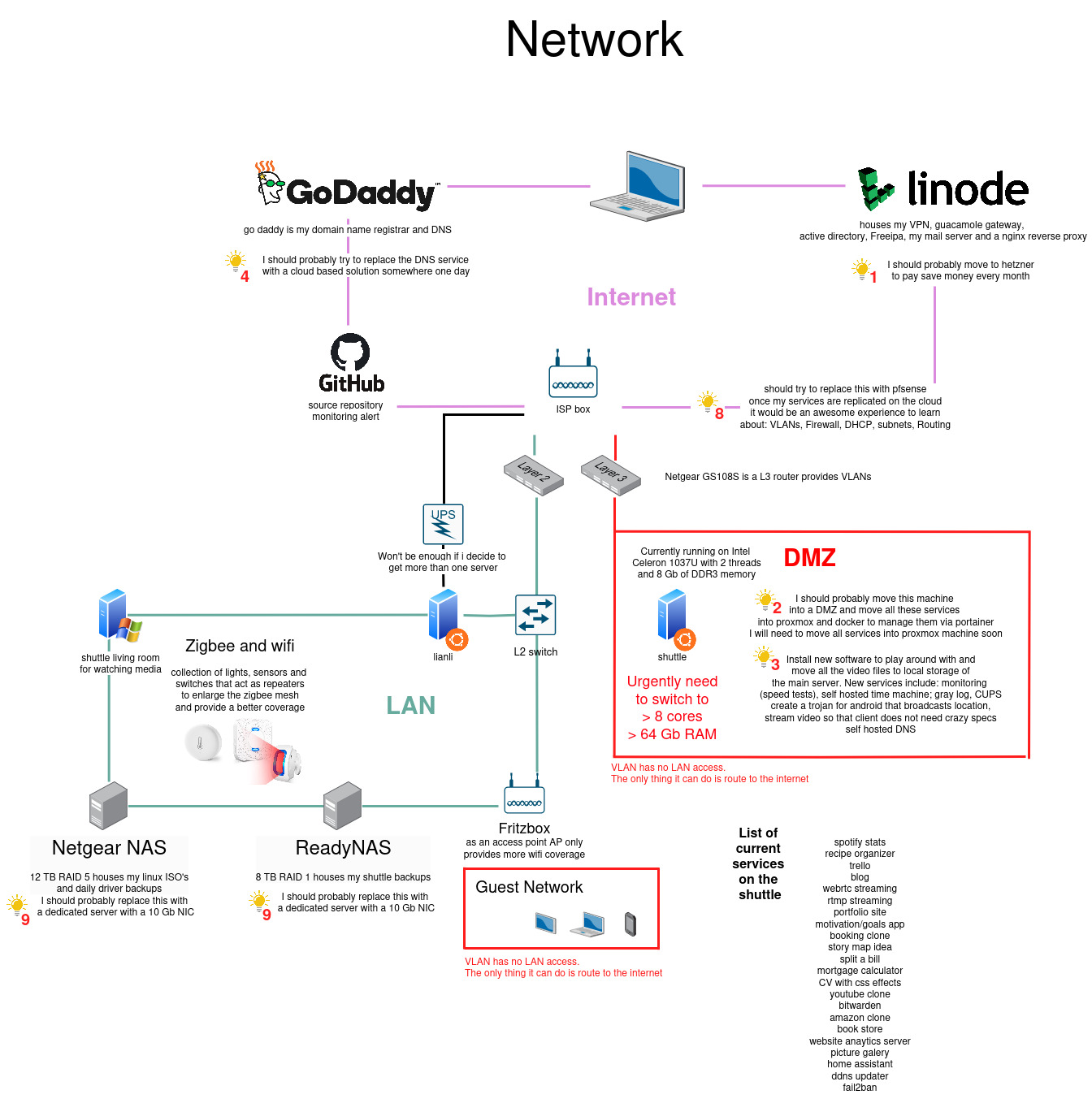
26th of April 2024 update: On my last update I introduced VLANs on a subset of test systems. Vlans are now operational in production with proper firewalls rules. Linode was shutdown and the services were copied over to Hetzner due to cost reasons.
On the hypervisor side I managed to acquire a similar machine to the existing one. I did not build a cluster because it allows me to play around with the networking more freely. Having corosync running imposes a lot of restrictions and they outweigh the benefits of setting up a cluster so I’ll keep those separate for now. This effectively means that I can have a productive and a test system that makes my services available even during downtime. Moving VMs from one host to the other takes a couple of hours because I intend to use nightly backups on the NAS to move machines around so I am limited to megabit transfer speeds. Despite the old hardware I happy with the result.
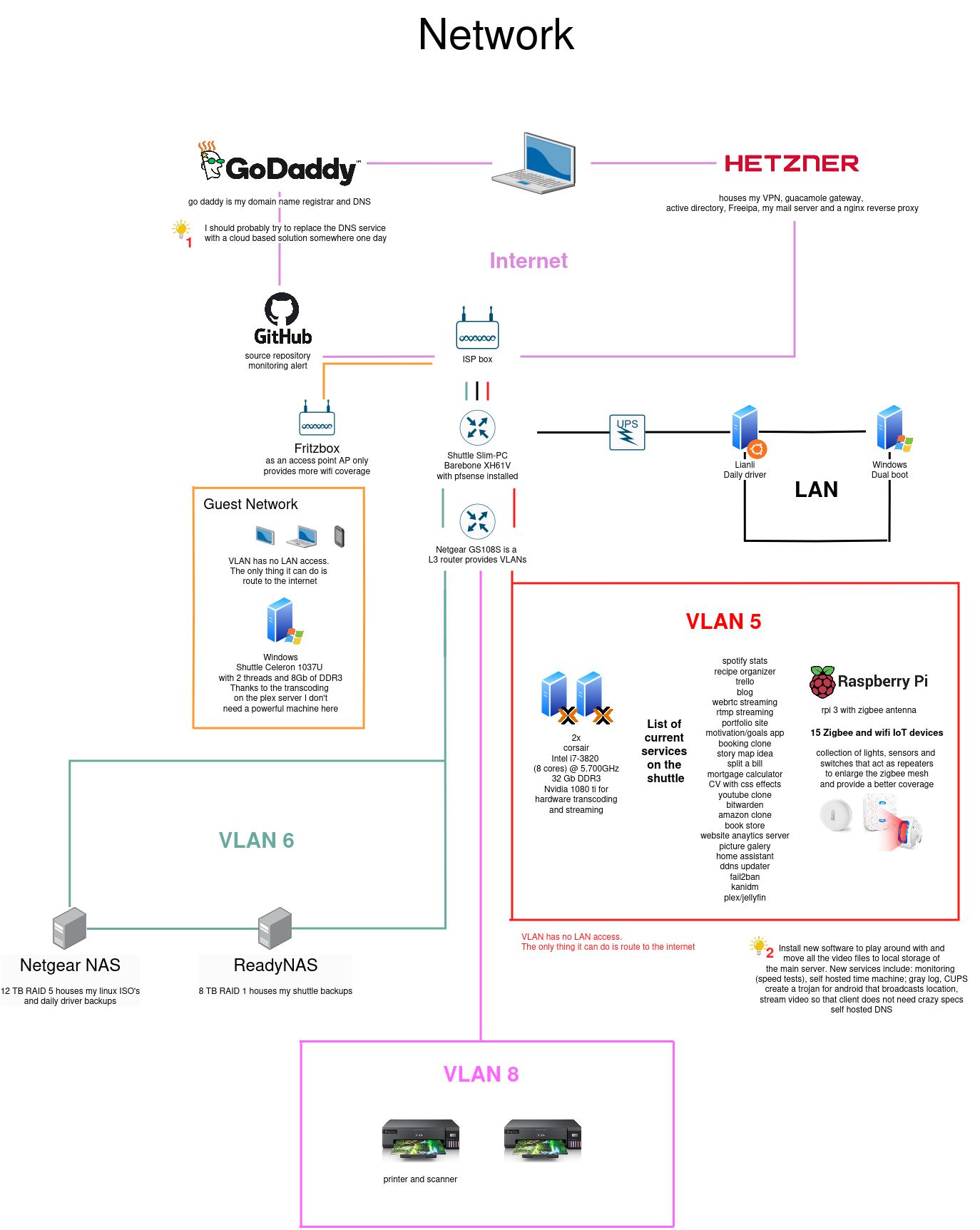
17th of September 2024 update: Bigger, better, faster, stronger. Shout out to Kj Networx GmbH for selling those switches at a very good price.
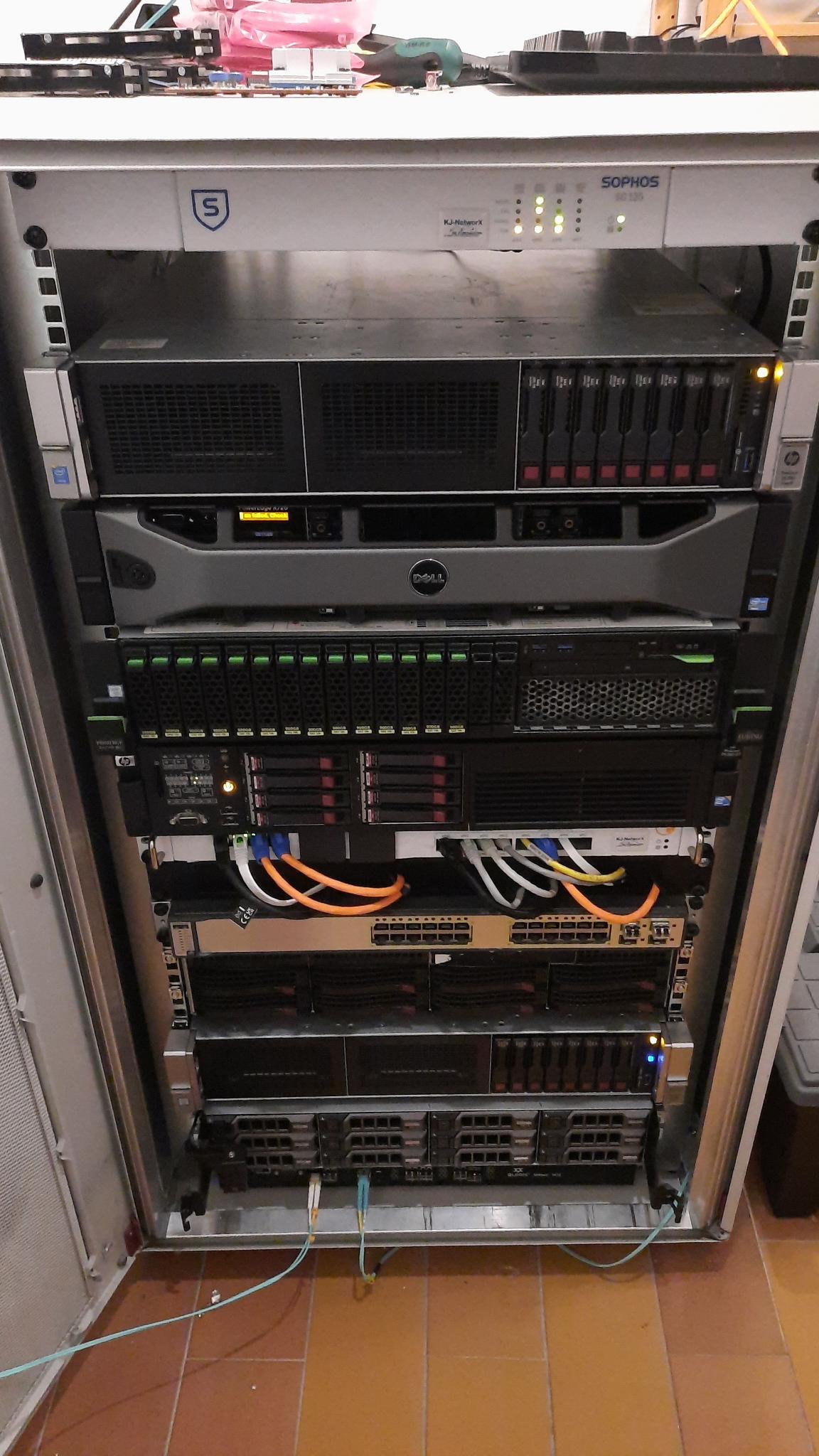
The network has gotten a complete overhaul once again. There are now two cat7 cables and a fibre connection going from my office to the basement. Here’s a small glimpse at what’s changed.
Old gear is highly deflationary so I could find some pretty good deals and repurposed some of it to fit my use case. The core of the network is on the top of the rack with a Sophos SG135 running pfsense. I originally bought a dirt cheap UTM220 Sophos firewall to act as my router and firewall but unfortunately the power consumption at idle on this old hardware led me to throw out the mainboard and repurpose the chassis to house my two small 8 port switches.
The 2 DL380 gen9 servers and the poweredge R720 will be my main production cluster. I plan to run a ceph cluster on that hardware once I get some proper network cards or try to go the SAN route with my fiber QLogic Sanbox 3810 switch on the bottom. I’ve had the chance to play around with the Fujitsu Emulex cards but unfortunately Broadcom only supports windows 10 drivers and my motherboard doesn’t support PCI passthrough to an ubuntu 20.04 VM so I couldn’t reap the benefits of fast backups at gigabit speeds yet. Those three servers are running SAS HDD’s so let’s see what speeds I get.
The supermicro and the dell R510 are my only servers that house 3.5 inch HDD’s. The supermicro houses all of my rsync backups and the Dell is the cold storage running ZFS. The backups are triggered manually but I intend to spin up a proxmox backup VM that syncs the data between these two backup servers.
The cisco catalyst PoE switch is largely overkill especially in terms of power consumption so i’ll turn this one on once I get my own house and get proper cabling around the house that doesn’t make it look like some mad man’s house. There are 3 PoE standards out there so I’ll have to make sure that my switch supports the camera’s requirements.
The fujitsu primergy with the green thumbs on the picture houses my k3s cluster. I’ve only recently dipped my fingers in the kubernetes space because it recently got introduced at work so I needed a playground that could help me bridge some knwoledge gaps and hopefully run the react docker projects, like Susanna’s book store, into an autonomous environment that is able to auto scale up/down and provide zero downtime thanks to the k3s’ ingress. Hopefully by next year I will be able to tweak and manage k8s by myself.
